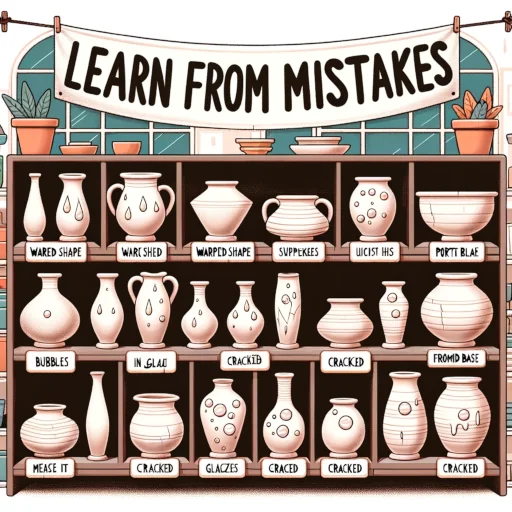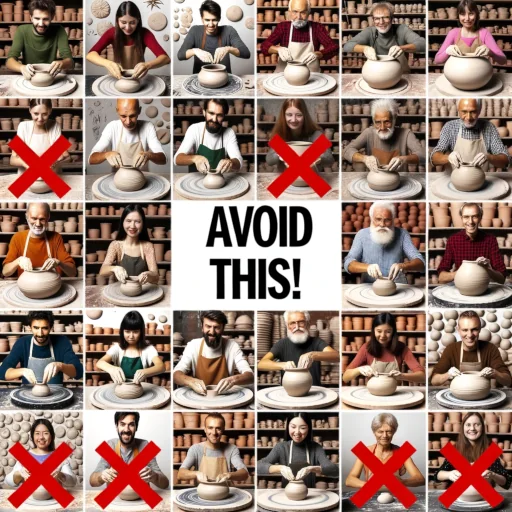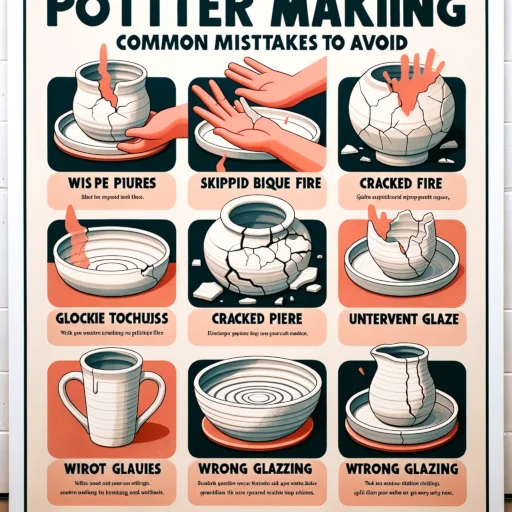From improper clay preparation to neglecting the drying process, mistakes can easily derail your project. One common error is skipping the bisque fire, which can lead to warping and cracking during the glaze firing. Another frequent mistake is using incorrect glazing techniques, resulting in issues like uneven glaze and bubbles. Using the wrong tools or using them improperly can also lead to uneven shapes and cracks. It’s essential to be aware of these pitfalls to create beautiful, functional pottery.
Avoiding common mistakes in pottery making is not just about salvaging a single piece; it’s about mastering the craft and elevating your skills to a professional level. Mistakes can be costly in terms of time, materials, and even your enthusiasm for the craft. Proper preparation is key; understanding your clay type, knowing how to wedge it correctly, and being aware of its moisture level can make or break your project. Similarly, understanding the techniques, whether you’re coiling, pinching, or throwing on a wheel, is crucial for achieving the desired results. Each mistake avoided is a step closer to creating a piece that is both beautiful and functional.1

Importance of Proper Preparation
Key Point: Proper preparation saves time and avoids headaches later on.
Proper preparation in pottery making is like laying a strong foundation for a building; it sets the stage for everything that follows. Preparing your clay correctly, for instance, ensures that it’s free of air bubbles and has a uniform consistency, which makes it easier to shape and less likely to crack during firing. Similarly, having your tools ready and within arm’s reach means you won’t have to interrupt your workflow, keeping your focus sharp and your hands steady.
The key takeaway here is that proper preparation saves you time in the long run. It may seem quicker to dive right in, but the headaches you’ll avoid by taking a few extra minutes to prepare can be significant. Whether it’s the frustration of a piece cracking, the time spent fixing mistakes, or even the cost of wasted materials, a little preparation goes a long way in avoiding these pitfalls.
Mistake 1: Not Considering Functionality
Key Point: Pottery should be both decorative and functional.
I say one common mistake beginners make is focusing solely on the aesthetic aspect of pottery, neglecting its functionality. While it’s great to create a piece that’s visually appealing, it’s equally important to consider how it will be used. For example, if you’re making a mug, think about the handle’s comfort and the lip’s smoothness. If it’s a vase, consider its stability and whether it can hold water without leaking.
The key point is that good pottery serves a dual purpose: it’s both decorative and functional. To ensure functionality, always keep the end-use in mind. Sketch out your design beforehand, thinking about dimensions and proportions. Test out handles and spouts to make sure they’re not just decorative but also practical. By giving equal weight to both form and function, you’ll create pieces that are not only beautiful but also useful.
Mistake 2: Not Preparing the Clay Properly

Key Point: Issues like cracking and warping can occur.
A frequent mistake that can lead to a host of problems is not preparing the clay properly. When clay isn’t adequately prepared, issues like cracking, warping, and uneven drying can occur, ruining hours of hard work. These issues often stem from inconsistencies in the clay, such as air bubbles or varying moisture levels.
The key point here is that proper clay preparation is crucial for a successful pottery project. To avoid these pitfalls, spend time wedging the clay to remove air bubbles and achieve a uniform consistency. If you’re recycling clay, make sure it’s well-mixed to avoid dry or overly wet spots. Always start with a clay slab that has a consistent thickness, as this will help prevent warping during the drying and firing stages. By dedicating time to properly prepare your clay, you’ll save yourself from potential headaches later on.
Mistake 3: Neglecting the Drying Process

Key Point: Quick drying can lead to cracks and warping.
One of the most overlooked aspects of pottery making is the drying process. Rushing this step can lead to cracks, warping, and other structural issues that compromise the integrity of your piece. The key point to remember is that clay needs to dry slowly and evenly to maintain its shape and avoid defects.
To ensure proper drying, keep your pottery covered with a plastic sheet or damp cloth to control the rate of moisture loss. If possible, rotate the piece periodically to encourage even drying. It’s also advisable to keep the pottery in a stable environment, away from direct sunlight, drafts, or heat sources that could speed up the drying process. For thicker pieces, consider hollowing out certain areas to promote uniform drying. By paying close attention to the drying process, you can significantly reduce the risk of cracks and warping.
Mistake 4: Improper Use of Tools
Key Point: Wrong tools can lead to uneven shapes and cracks.
Improper use of tools is a common pitfall that can lead to a host of problems, including uneven shapes, cracks, and even the collapse of your pottery piece. The key takeaway here is that using the right tools in the right way is crucial for achieving the desired outcome.
Firstly, make sure you’re using tools that are appropriate for the task at hand. For example, using a needle tool instead of a fettling knife for cutting could result in uneven edges. Secondly, keep your tools clean and well-maintained. Dirty or dull tools can drag on the clay, causing imperfections.
When using tools like ribs, scrapers, or loop tools, make sure you hold them at the correct angle and apply consistent pressure to avoid gouging or tearing the clay. If you’re new to pottery, consider watching online tutorials or taking a class to learn the proper techniques for tool usage. By investing time in learning how to use your tools correctly, you’ll save yourself a lot of trouble and end up with a much better finished product.
Mistake 5: Skipping the Bisque Fire

Key Point: Skipping this step can lead to issues like warping and cracking during glaze firing.
Skipping the bisque fire is a mistake that can have serious consequences for your pottery, including warping and cracking during the glaze firing. The key point here is that bisque firing serves as a crucial preparatory step for glaze firing, helping to remove physical and chemical water from the clay, making it more porous and ready to accept glaze.
Firstly, ensure your pottery is bone dry before loading it into the kiln for bisque firing. Any residual moisture can turn into steam and cause the piece to crack or explode. Secondly, stack your pottery carefully in the kiln, ensuring there’s enough space between pieces for even heat distribution.
The temperature for bisque firing generally ranges from Cone 06 to 04. It’s crucial to ramp up the temperature slowly, especially during the initial stages, to allow any remaining moisture to escape. Once the bisque firing is complete, you’ll have a much more stable and porous piece that’s ready for glazing. This step is not to be skipped if you want to avoid a host of issues later on.
Mistake 6: Incorrect Glazing Techniques
Key Point: Issues like uneven glaze and bubbles can occur.
Incorrect glazing techniques can lead to a variety of issues, such as uneven glaze application, bubbles, or even the glaze dripping off the pottery during firing. The key point to remember is that proper glazing techniques are essential for achieving a smooth, even finish that enhances your pottery’s aesthetic and functional qualities.
Firstly, make sure your bisque ware is clean and free of dust or oils, as these can interfere with glaze adhesion. Use a damp sponge or cloth to wipe down the surface before applying glaze. Secondly, ensure your glaze is well-mixed and free of lumps. Straining the glaze through a sieve can help achieve a smooth consistency.
When applying the glaze, techniques like brushing, pouring, and dipping each have their pros and cons. For example, brushing offers more control but can lead to brush marks, while dipping is quicker but may result in a thicker application. Regardless of the method you choose, aim for even coverage and be mindful of the glaze’s thickness. Too thick a layer can lead to running or pooling, while too thin may result in a patchy finish.
Lastly, always test your glazes on a small piece or test tile before committing to a larger project. This will give you an idea of the final color and texture, helping you avoid any unpleasant surprises.
Footnotes
- Pottery Book for Beginners: An Instruction Guide for Potters to Sculpt Wheel Thrown and Handbuilding Ceramic Projects With Tips, Techniques and Pottery Tools Included. N.p.: Wade Marsh, (n.d.). ↩︎





